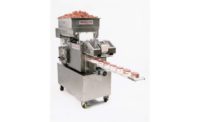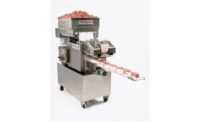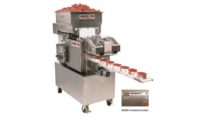It is no surprise that consumers show loyalty and preference for brands that understand their concerns about health and wellness. Organic and natural foods are preferred by consumers all around the world for their health benefits – and many consumers do not mind the premium prices that come along with these products. While these consumer preferences offer an opportunity for food brands to innovate and expand, food suppliers, distributors and retailers are all challenged to extend the shelf life of natural and organic foods without compromising the real taste, texture or color of these goods.
The process involved in designing the “perfect” food forming or depositing system is deceptively complicated. There are many goals that need to be achieved in the design process because not all products are the same and not all processors are looking for the same features in their formed portions. Some of the key industry demands that are common include:
- Accurate portion weight
- Consistent portion shape; formed and finished
- High volume repeatability
- Particle definition
The “perfect” system would simply take the base material presented and re-shape it into the proper portion size/shape/weight with minimal introduction of mechanical energy. Some food forming and depositing systems have been uniquely designed to deliver on all of these requirements, plus more.
The process starts with the Product Delivery System, which combines the product feed hopper and the product rotor design. All forming systems include some type of metering hopper that brings the product toward the fill area. However, the key to high quality, consistent forming is how this is achieved and ultimately concerns how the product gets introduced to the fill area.
Starting with the product hopper, there are two basic designs: conical or rectangular. All product hopper designs use augers or screws to move the product from the zone where it was loaded toward the fill area. Product must be delivered to the fill area at approximately the same rate that is required for production. For example, if the forming system is producing (4) 4.0 oz. portions per stroke, at least 16.0 oz. of product must be delivered to the fill area for each forming plate stroke.
Some food forming equipment manufacturers offer both conical and rectangular product hopper designs. The choice of design is based on the required output volume; the higher the required output, the larger the product hopper. The critical design difference is that the product feed is adjustable to match the required output to eliminate under- or overfeeding the forming zones. Underfeeding will result in the inability to form at the required production rate or partially formed portions. Overfeeding can cause a great many issues including excessive introduction of mechanical energy, which fundamentally changes the quality of the product and destroys particle definition. If the product is overworked in this process, no forming or depositing system in the world can repair this damage. The proper feed rate and method is critical to overall product quality.
The way product is delivered from the hopper to the mold plate can make the greatest difference in quality food forming. Using a vane-style rotor is common in many delivery systems. What sets rotors apart, however, is their width. When the width of the rotor matches the width of the fill area, product is not forced from the output of the pump into a tube for delivery. Instead, product is gently fed through an orifice that matches the required forming width. This helps reduce further introduction of mechanical energy, reduces shear edges that can damage particle integrity and produces a constant, yet fully adjustable volume. The end result is accurate portion weight, consistent shapes, high volume repeatability and excellent particle definition. NP
For more information, visit www.nutecmfg.com.









